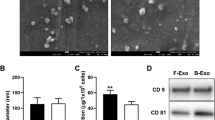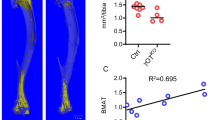Abstract
Mesenchymal stem cells (MSCs) are multipotent stem cells that are able to differentiate into several cell types, including cartilage, fat, and bone. It has been reported that the decision process of MSCs into fat and bone cells is competing and reciprocal. Interleukin (IL)-35 is an important effector protein in the Wnt/β-catenin signaling pathway that acts as a bone metabolism regulator. However, it is unclear whether IL-35 is also important for regulating MSC differentiation to fat and bone. In the current study, we evaluated the role of IL-35 in C3H10T1/2 cells, which are a good cell model for investigating osteogenesis and adipogenesis in bone marrows. The role of IL-35 on osteoblast proliferation and apoptosis was assessed using cell counting kit-8 assay and flow cytometry, respectively. Extracellular matrix mineralization and lipid accumulation were measured by Alizarin Red S staining and Oil Red O staining, respectively. The most important transcription factor of the process of osteogenesis Runx2 and Wnt/β-catenin signaling pathway components β-catenin and Axin2 were investigated in response to IL-35 treatment. Furthermore, the adipogenic markers PPAR-γ and C/EBPα were also investigated. Our observations showed that IL-35 could promote the proliferation of MSCs and inhibit the apoptosis of MSCs. We found that IL-35 treatment resulted in a dramatic stimulation of osteogenesis and inhibition of adipogenesis. Moreover, IL-35 enhanced Wnt/β-catenin pathway key component β-catenin as well as Axin2 expression during MSCs differentiated to osteoblasts. Our findings suggested that IL-35 might control the balance between osteogenic and adipogenic differentiation of progenitor cells through the Wnt/β-catenin-PPARγ signaling pathway, suggesting its potential application in providing an intervention in osteoporosis and obesity.






Similar content being viewed by others
Availability of Data and Material
The data used to support the findings of this study are available from the corresponding author upon request.
References
Gimble, J.M., S. Zvonic, Z.E. Floyd, M. Kassem, and M.E. Nuttall. 2006. Playing with bone and fat. Journal of cellular biochemistry 98 (2): 251–266.
Chen, Q., P. Shou, C. Zheng, M. Jiang, G. Cao, Q. Yang, J. Cao, N. Xie, T. Velletri, X. Zhang, C. Xu, L. Zhang, H. Yang, J. Hou, Y. Wang, and Y. Shi. 2016. Fate decision of mesenchymal stem cells: Adipocytes or osteoblasts? Cell death and differentiation 23 (7): 1128–1139.
Hu, L., C. Yin, F. Zhao, A. Ali, J. Ma, and A, Qian. 2018. Mesenchymal stem cells: Cell fate decision to osteoblast or adipocyte and application in osteoporosis treatment. International journal of molecular sciences 19 (2).
Liu, S., Y. Li, L. Xia, H. Shen, and J. Lu. 2019. IL-35 prevent bone loss through promotion of bone formation and angiogenesis in rheumatoid arthritis. Clinical and experimental rheumatology 37 (5): 820–825.
Kamiya, Y., T. Kikuchi, H. Goto, I. Okabe, Y. Takayanagi, Y. Suzuki, N. Sawada, T. Okabe, Y. Suzuki, S. Kondo, J.I. Hayashi, and A. Mitani. 2020. IL-35 and RANKL synergistically induce osteoclastogenesis in RAW264 mouse monocytic cells. International journal of molecular sciences 21 (6).
Peng, M., L. Qiang, Y. Xu, C. Li, T. Li, and J. Wang. 2019. IL-35 ameliorates collagen-induced arthritis by promoting TNF-α-induced apoptosis of synovial fibroblasts and stimulating M2 macrophages polarization. The FEBS journal 286 (10): 1972–1985.
Wu, S., Y. Li, Y. Li, L. Yao, T. Lin, S. Jiang, H. Shen, L. Xia, and J. Lu. 2016. Interleukin-35 attenuates collagen-induced arthritis through suppression of vascular endothelial growth factor and its receptors. International immunopharmacology 34: 71–77.
Liu, J.Q., Z. Liu, X. Zhang, Y. Shi, F. Talebian, J.W. Carl Jr., C. Yu, F.D. Shi, C.C. Whitacre, J. Trgovcich, and X.F. Bai. 2012. Increased Th17 and regulatory T cell responses in EBV-induced gene 3-deficient mice lead to marginally enhanced development of autoimmune encephalomyelitis. The Journal of Immunology 188 (7): 3099–3106.
Collison, L.W., V. Chaturvedi, A.L. Henderson, P.R. Giacomin, C. Guy, J. Bankoti, D. Finkelstein, K. Forbes, C.J. Workman, S.A. Brown, J.E. Rehg, M.L. Jones, H.T. Ni, D. Artis, M.J. Turk, and D.A. Vignali. 2010. IL-35-mediated induction of a potent regulatory T cell population. Nature immunology 11 (12): 1093–1101.
Li, Y., L. Yuan, S. Jiang, S. Liu, L. Xia, H. Shen, and J. Lu. 2019. Interleukin-35 stimulates tumor necrosis factor-α activated osteoblasts differentiation through Wnt/β-catenin signaling pathway in rheumatoid arthritis. International immunopharmacology 75: 105810.
Long, J., H. Guo, S. Cui, H. Zhang, X. Liu, D. Li, Z. Han, L. Xi, W. Kou, J. Xu, T.S. Li, and Y. Ding. 2016. IL-35 expression in hepatocellular carcinoma cells is associated with tumor progression. Oncotarget 7 (29): 45678–45686.
Wetzel, A., B. Scholtka, F. Schumacher, H. Rawel, B. Geisendörfer, and B. Kleuser. 2021. Epigenetic DNA Methylation of EBI3 modulates human interleukin-35 formation via NFkB signaling: A promising therapeutic option in ulcerative colitis. International journal of molecular sciences, 22 (10).
Zhang, T., J. Nie, X. Liu, Z. Han, N. Ding, K. Gai, Y. Liu, L. Chen, and C. Guo. 2021. Correlation analysis among the level of IL-35, microvessel density, lymphatic vessel density, and prognosis in non-small cell lung cancer. Clinical and translational science 14 (1): 389–394.
Kam, N.W., D. Liu, Z. Cai, W.Y. Mak, C.K. Wong, K.H. Chiu, K.Y. Wong, W.L. Tsang, and L.S. Tam. 2018. Synoviocytes-derived interleukin 35 potentiates B cell response in patients with osteoarthritis and rheumatoid arthritis. The Journal of rheumatology 45 (4): 563–573.
Li, Y., L. Yao, S. Liu, W. Jisheng, L. Xia, H. Shen, and J. Lu. 2019. Correlation between serum IL-35 levels and bone loss in postmenopausal women with rheumatoid arthritis. Mediators of Inflammation 9139145.
Han, Y., C. Yu, Y. Yu, and L. Bi. 2021. CD25+ B cells produced IL-35 and alleviated local inflammation during experimental periodontitis. Oral diseases.
Mann, H., O. Kryštůfková, J. Zámečník, J. Háček, H. Hulejová, M. Filková, J. Vencovský, and L. Šenolt. 2021. Interleukin-35 in idiopathic inflammatory myopathies. Cytokine 137: 155350.
Zhang, X., Y. Zhou, L. Xu, W. Han, H. Chen, Y. Chen, H. Fu, S. Zhou, J. Zhao, Q. Wang, F. Feng, X. Zhu, K. Liu, and X. Huang. 2015. Reduced IL-35 levels are associated with increased platelet aggregation and activation in patients with acute graft-versus-host disease after allogeneic hematopoietic stem cell transplantation. Annals of hematology 94 (5): 837–845.
Ferrara, G., F. Ivaldi, G. Mancardi, N. Kerlero de Rosbo, and A. Uccelli. 2021. Bone marrow transfer in relapsing-remitting EAE ameliorates disease at first remission, with no synergistic effect upon co-transplantation with mesenchymal stem cells. Vaccines 9 (7).
Shi, Y., L. Du, L. Lin, and Y. Wang. 2017. Tumour-associated mesenchymal stem/stromal cells: Emerging therapeutic targets. Nature reviews Drug discovery 16 (1): 35–52.
Lin, G.L., and K.D. Hankenson. 2011. Integration of BMP, Wnt, and notch signaling pathways in osteoblast differentiation. Journal of cellular biochemistry 112 (12): 3491–3501.
Abdallah, B.M. 2017. Marrow adipocytes inhibit the differentiation of mesenchymal stem cells into osteoblasts via suppressing BMP-signaling. Journal of biomedical science 24 (1): 11.
Zhang, L., M. Liu, X. Zhou, Y. Liu, B. Jing, X. Wang, Q. Zhang, and Y. Sun. 2016. Role of osteoprotegerin (OPG) in bone marrow adipogenesis. Cellular Physiology and Biochemistry 40 (3–4): 681–692.
Tasso, R., C. Ilengo, R. Quarto, R. Cancedda, R.R. Caspi, and G. Pennesi. 2012. Mesenchymal stem cells induce functionally active T-regulatory lymphocytes in a paracrine fashion and ameliorate experimental autoimmune uveitis. Investigative ophthalmology & visual science 53 (2): 786–793.
Guo, H., N. Zhao, H. Gao, and X. He. 2017. Mesenchymal stem cells overexpressing interleukin-35 propagate immunosuppressive effects in mice. Scandinavian journal of immunology 86 (5): 389–395.
Arthur, A., A. Zannettino, and S. Gronthos. 2009. The therapeutic applications of multipotential mesenchymal/stromal stem cells in skeletal tissue repair. Journal of cellular physiology 218 (2): 237–245.
Burkhardt, R., G. Kettner, W. Böhm, M. Schmidmeier, R. Schlag, B. Frisch, B. Mallmann, W. Eisenmenger, and T. Gilg. 1987. Changes in trabecular bone, hematopoiesis and bone marrow vessels in aplastic anemia, primary osteoporosis, and old age: A comparative histomorphometric study. Bone 8 (3): 157–164.
Moldes, M., Y. Zuo, R.F. Morrison, D. Silva, B.H. Park, J. Liu, and S.R. Farmer. 2003. Peroxisome-proliferator-activated receptor gamma suppresses Wnt/beta-catenin signalling during adipogenesis. The Biochemical journal 376 (Pt 3): 607–613.
Funding
This study was funded by the China Postdoctoral Science Foundation (2019M661173) and the 345 Talent Project of Shengjing Hospital of China Medical University.
Author information
Authors and Affiliations
Contributions
XF W and J.L. designed the study and revised the manuscript. YX L performed the experiments. YX L drafted the manuscript. YX L analyzed the data.
Corresponding author
Ethics declarations
Consent for Publication
Written informed consent for publication was obtained from all participants.
Competing Interests
The authors declare no competing interests.
Additional information
Publisher's Note
Springer Nature remains neutral with regard to jurisdictional claims in published maps and institutional affiliations.
Supplementary Information
Below is the link to the electronic supplementary material.
10753_2022_1749_MOESM1_ESM.tif
Supplementary file1 JASPAR website was employed to predict the binding site of Axin2 and PPARγ. The promoter sequence of Axin2 was found and the score value was greater than 80%, suggesting the transcription of Axin2 could upregulate the PPARγ expression during the MSCs differentiate to adipocytes. (TIF 8512 KB)
Rights and permissions
Springer Nature or its licensor (e.g. a society or other partner) holds exclusive rights to this article under a publishing agreement with the author(s) or other rightsholder(s); author self-archiving of the accepted manuscript version of this article is solely governed by the terms of such publishing agreement and applicable law.
About this article
Cite this article
Li, Y., Wang, X. & Lu, J. Interleukin-35 Promote Osteogenesis and Inhibit Adipogenesis: Role of Wnt/β-Catenin and PPARγ Signaling Pathways. Inflammation 46, 522–533 (2023). https://doi.org/10.1007/s10753-022-01749-3
Received:
Revised:
Accepted:
Published:
Issue Date:
DOI: https://doi.org/10.1007/s10753-022-01749-3




